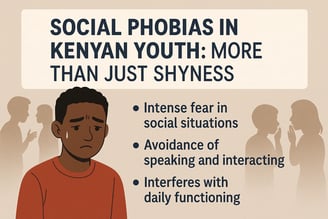Social Phobias in Kenyan Youth: More Than Just Shyness
While many teens describe themselves as “shy,” an estimated 7–9% actually struggle with social phobia (social anxiety disorder)—an intense fear of social situations that can derail friendships, classroom participation, and even future prospects. Here’s what educators, parents, and counselors need to know.
6/10/20251 min read


1. Recognizing the Signs
Avoidance: Reluctance or refusal to speak in class, join group activities, or attend social events.
Physical Symptoms: Heart racing, sweating, trembling, or nausea at the thought of social interaction.
Negative Self‑Talk: Persistent worries about being judged, embarrassed, or “looking stupid.”
2. Why It Matters in Kenyan Schools
Participation Gap: Students with social phobias often miss out on class discussions, group projects, and leadership roles—limiting both learning and confidence.
Isolation Spiral: Avoidance can lead to loneliness, which exacerbates anxiety and increases risk of depression.
Future Impact: Unaddressed social anxiety can hamper university interviews, job applications, and community engagement.
3. Low‑Cost, High‑Impact Strategies
Gradual Exposure: Start with low‑pressure tasks (e.g., reading aloud to one trusted peer) and build up to larger groups.
Skill‑Building Workshops: Role‑play exercises to practice introductions, eye contact, and small talk in a safe setting.
Peer Mentorship: Pair anxious students with empathetic classmates who can model social participation.
4. Leveraging Tech Tools
AI‑Guided Screening: Quick digital questionnaires can flag at‑risk students before teachers notice behavioral changes.
Virtual Reality (VR) Exercises: (Where available) Simulate social scenarios in a controlled environment to build confidence.
Mobile Check‑Ins: Daily mood‑tracking apps remind students to record anxiety levels and positive social interactions, creating data for counselors to tailor support.
5. Building a Supportive School Culture
Empathy Campaigns: School‑wide talks and posters that normalize anxiety and encourage peer support.
Teacher Training: Equip educators with strategies to facilitate inclusive discussions and gently encourage reluctant speakers.
Safe Zones: Designate “quiet corners” or “social chill‑out” spaces where students can regroup before rejoining activities.
Moving Forward
Social phobia isn’t just “extreme shyness”—it’s a treatable condition that thrives in silence. By combining understanding, targeted interventions, and smart technology, Kenya’s schools can turn social fear into social confidence, ensuring every young person has the chance to be seen, heard, and supported.
Have you worked with students facing social anxiety? Share your tips below and help us create more welcoming classrooms.
Student well-being
Transforming student well-being through innovative solutions.
Contact us
BeFiti ©2025. All rights reserved.
